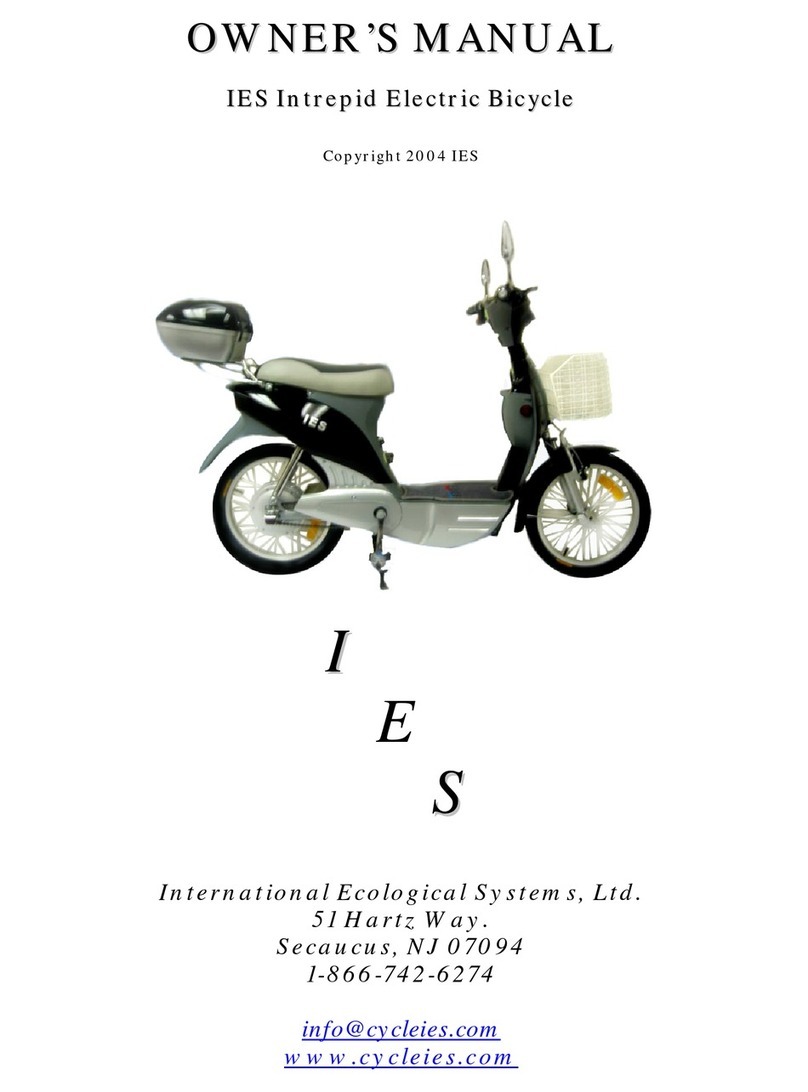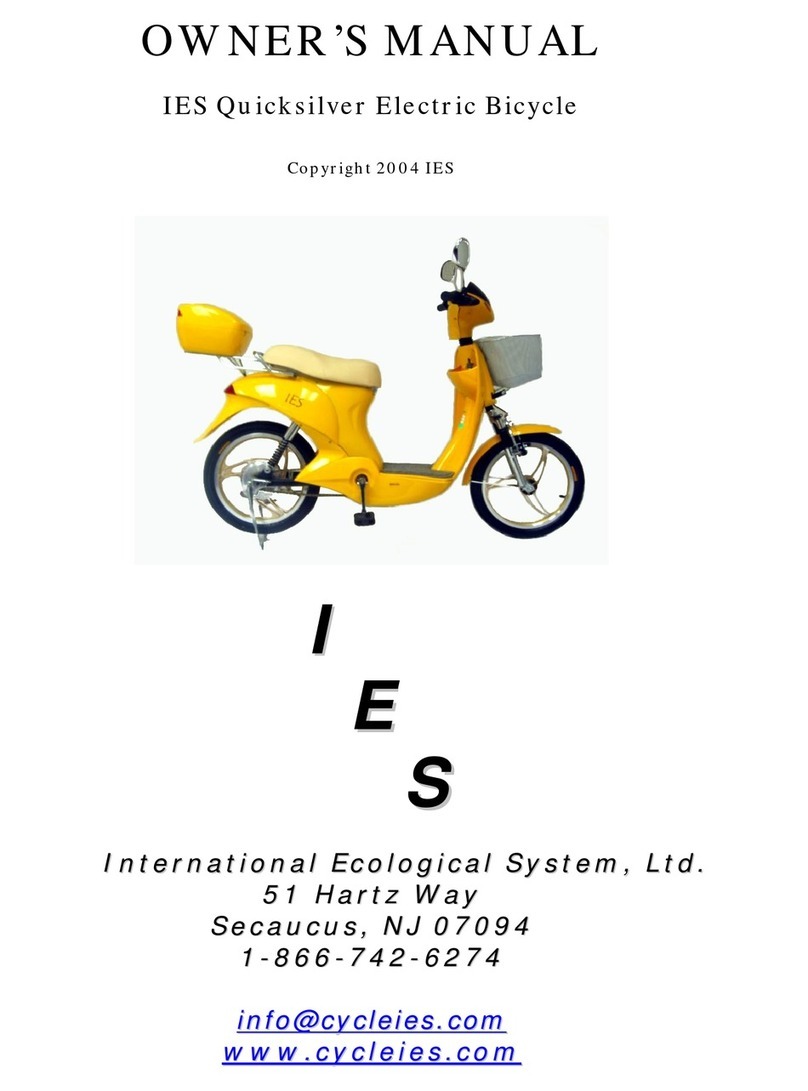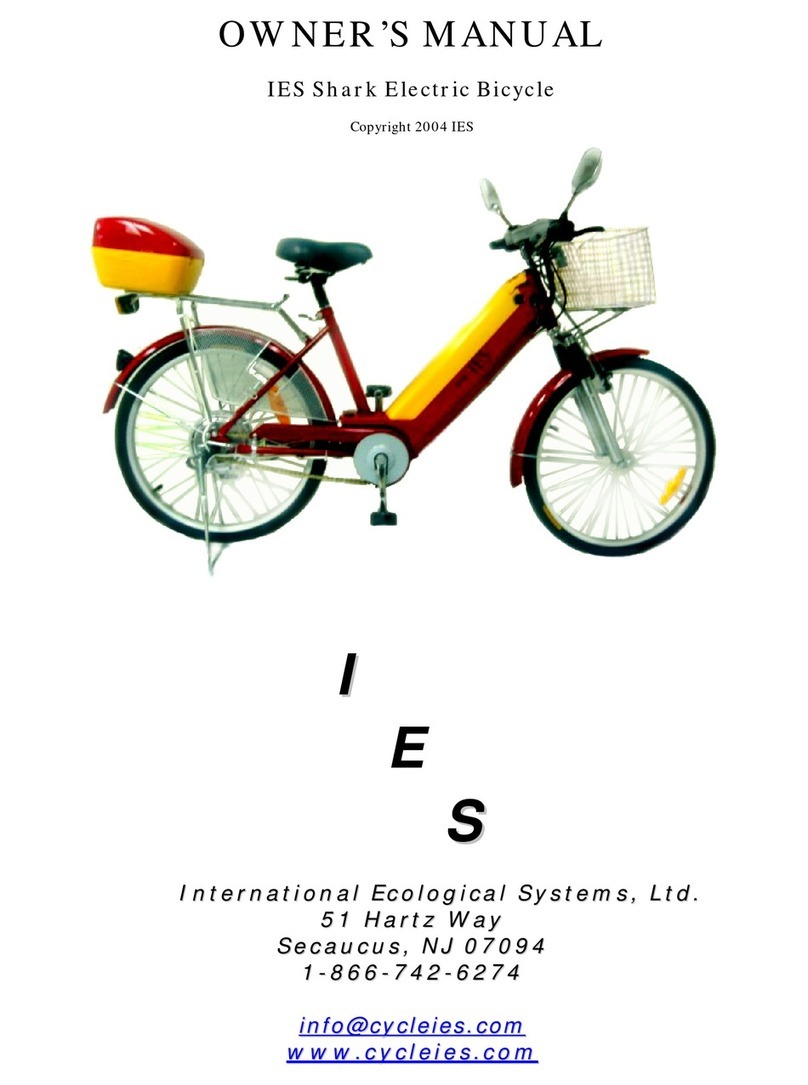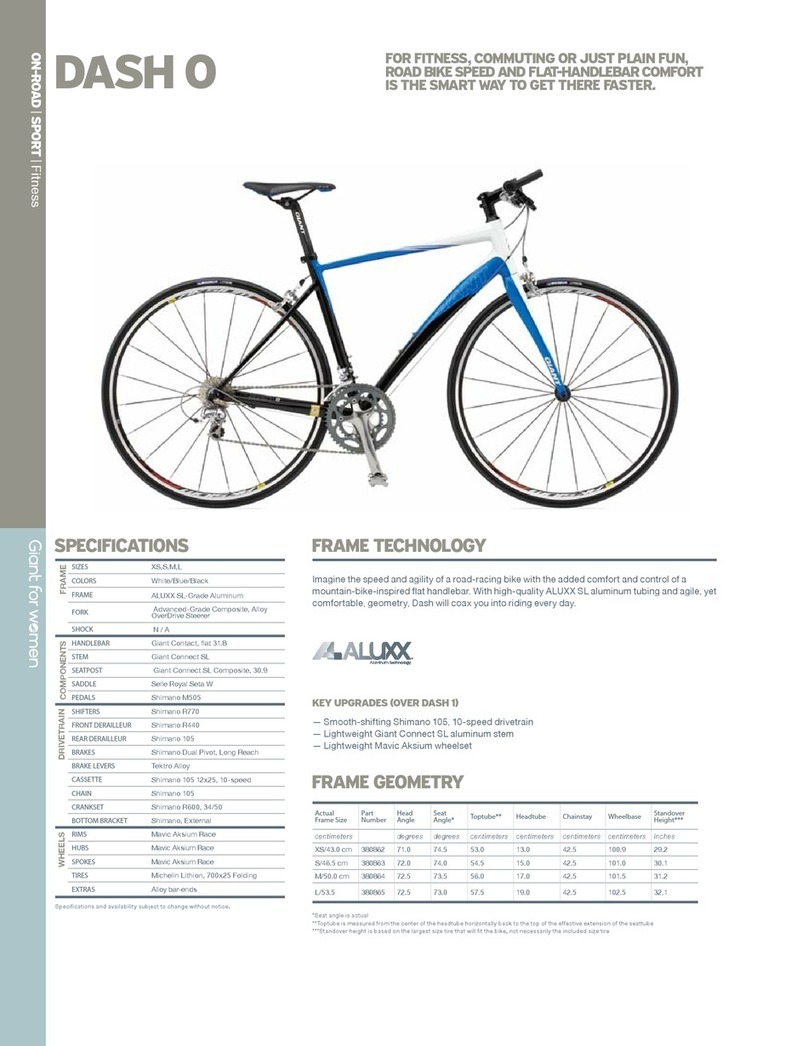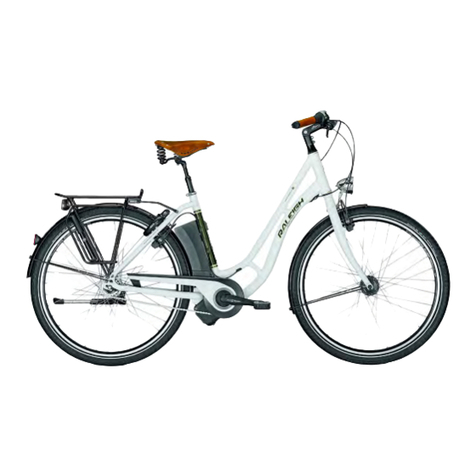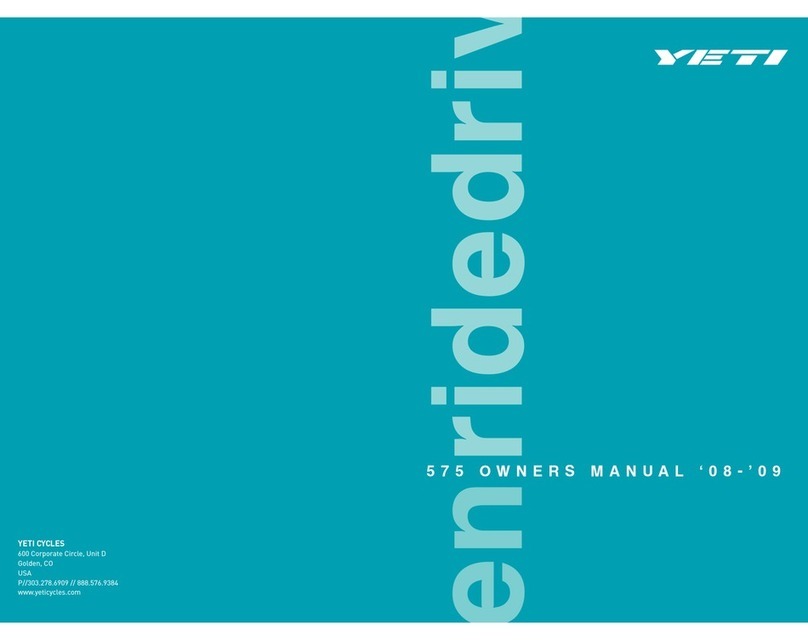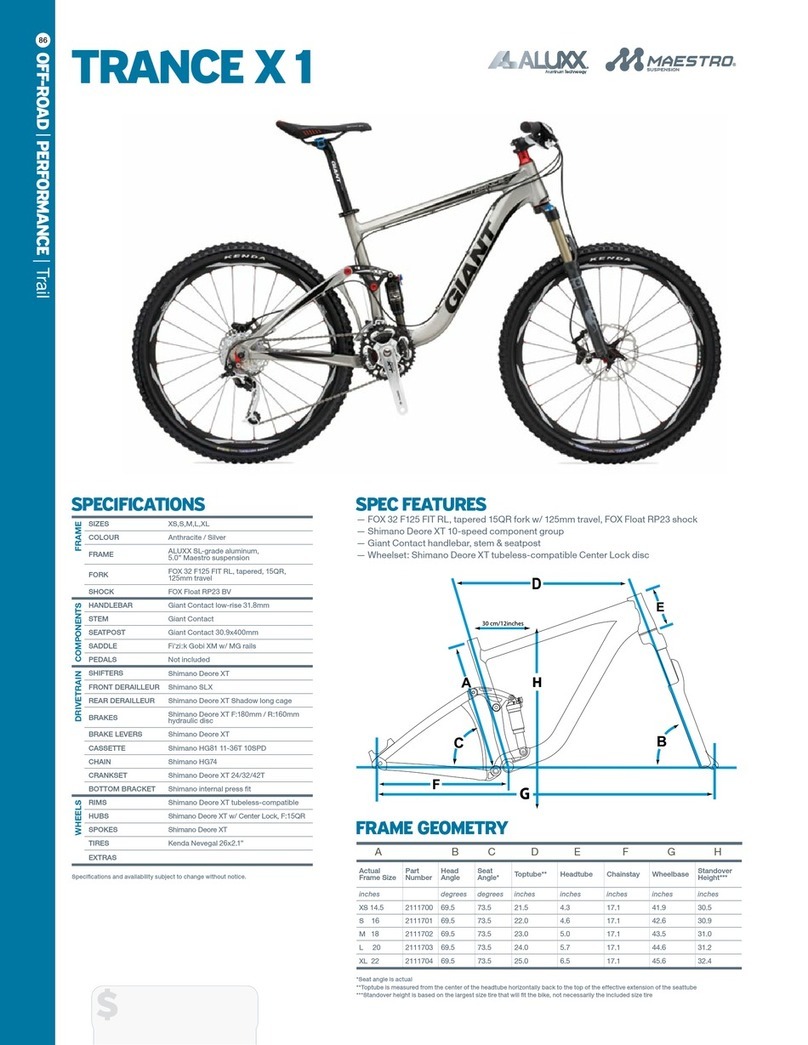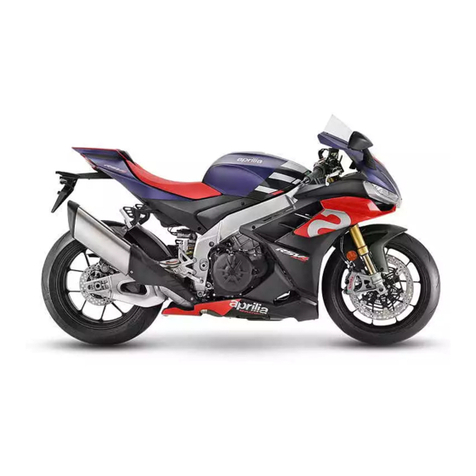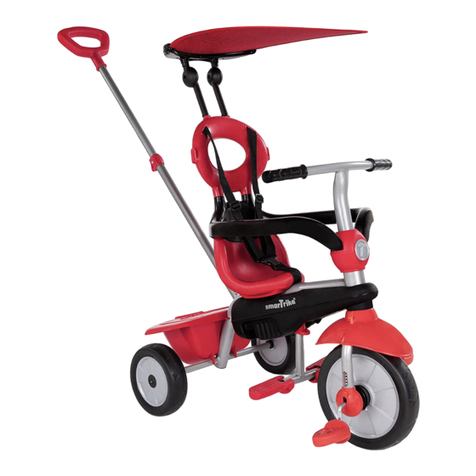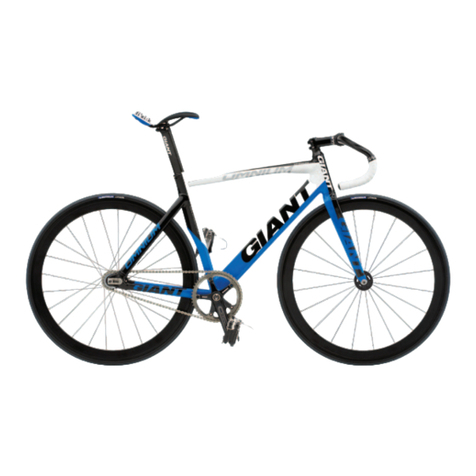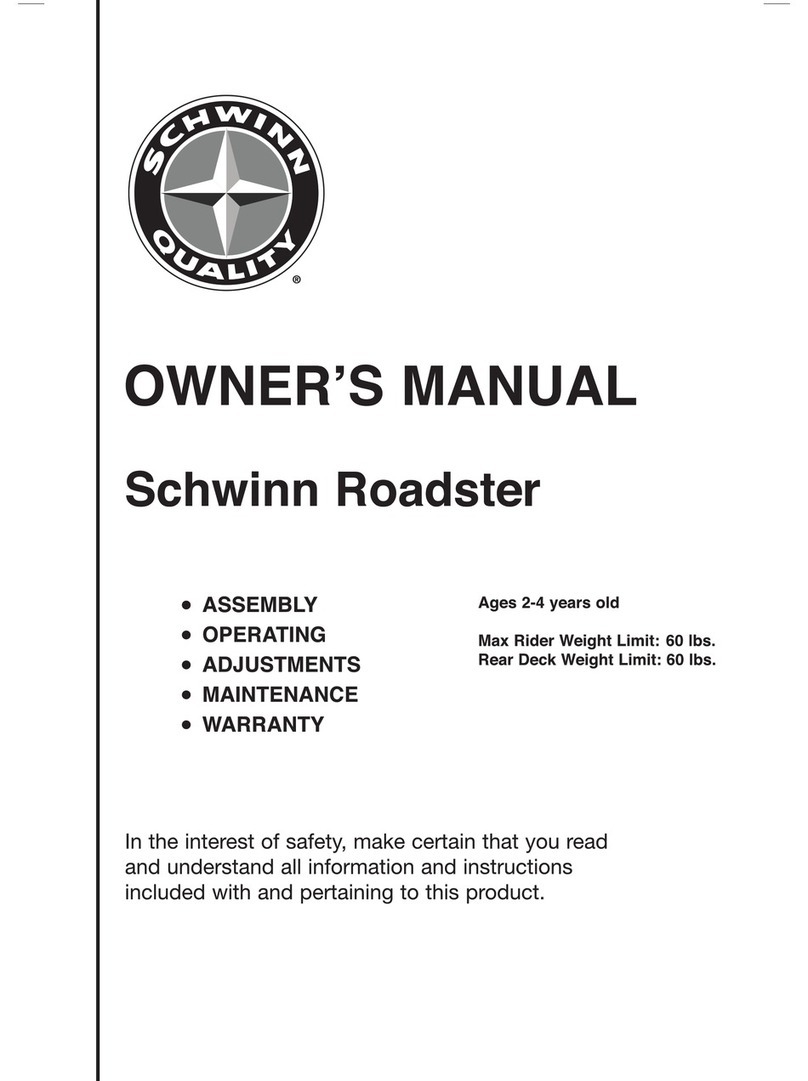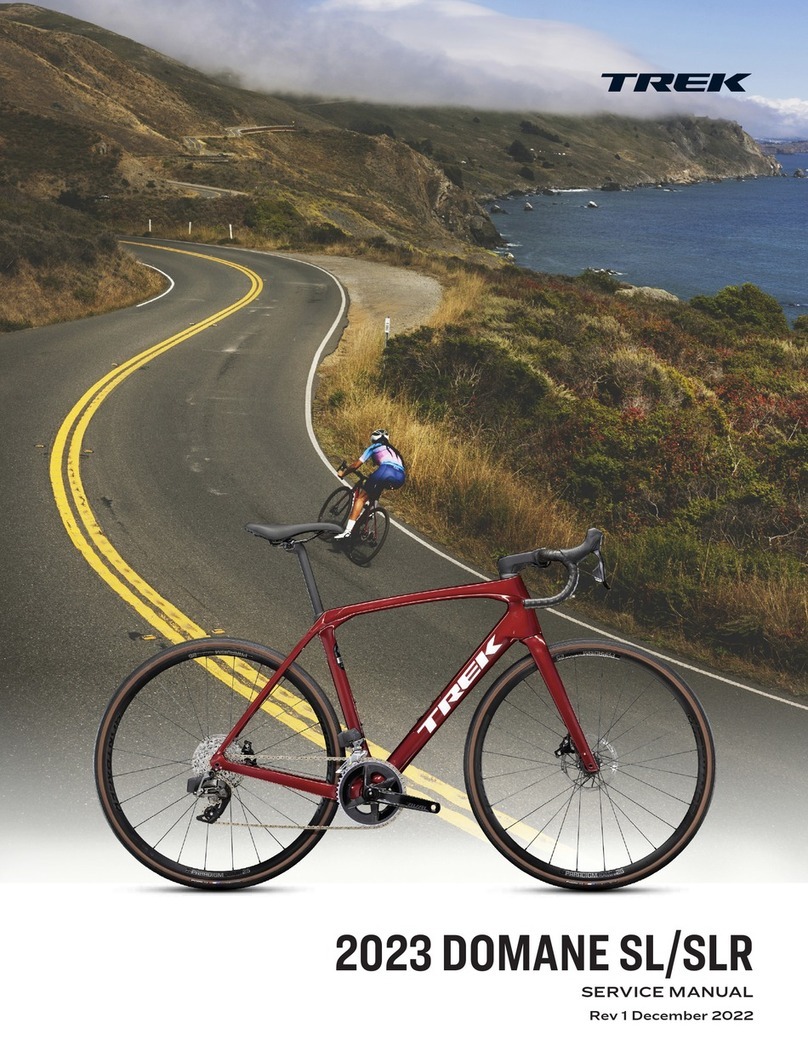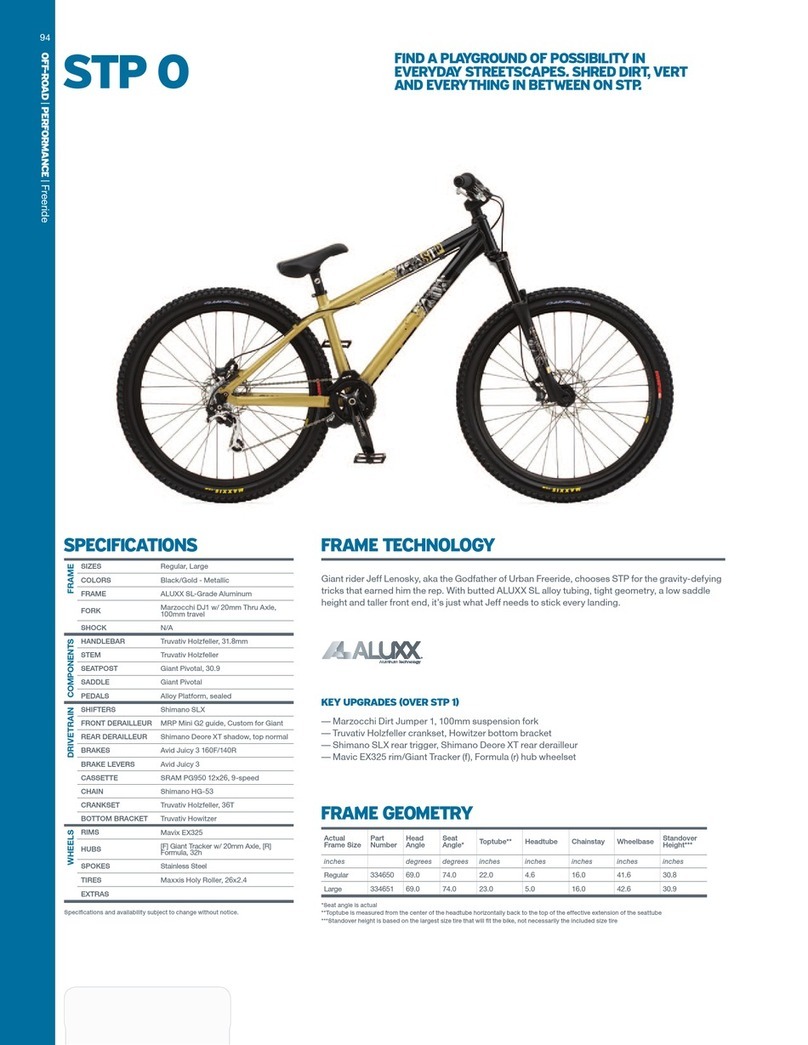IES Colt User manual

O
OW
WN
NE
ER
R’
’S
S
M
MA
AN
NU
UA
AL
L
IES Colt Electric Bicycle
Copyright 2003 by IES
I
I
E
S
S
International Ecological Systems, Ltd.
51 Hartz Way.
Secaucus, NJ 07094
1-866-742-6274
www.cycleies.com

O
OW
WN
NE
ER
R’
’S
S
M
MA
AN
NU
UA
AL
L
–
–
I
IE
ES
S
C
CO
OL
LT
T
I
IN
NT
TE
ER
RN
NA
AT
TI
IO
ON
NA
AL
L
E
EC
CO
OL
LO
OG
GI
IC
CA
AL
L
S
SY
YS
ST
TE
EM
MS
S,
,
L
LT
TD
D.
.
1
1-
-8
86
66
6-
-7
74
42
2-
-6
62
27
74
4
P
Pa
ag
ge
e
2
2
o
of
f
1
18
8
IMPORTANT!!
Congratulations on selecting the IES Colt. In order to use and enjoy your bicycle
safely and to get the best performance and durability from this product, please
read this manual before riding.
Warning! Even on the best days, riding or operating any sort of
vehicle can be hazardous. Always wear a helmet and use extra caution
to avoid accidents. This manual contains many cautions and warnings.
It is important that you read and understand the material outlined in
this manual.
We want you to be completely satisfied with your Colt. If you have any questions
or concerns, please call the IES team at 1-866-742-6274.
Each bicycle comes with a Vehicle Identification Number (VIN) embossed into the
frame. Please record the VIN along with other pertinent information below in the
event that the bicycle is lost or stolen. It may also be a good idea to register your
VIN number with the local police department.
VIN:
Model:
Color:
Date of
Purchase:
Place of
Purchase:

O
OW
WN
NE
ER
R’
’S
S
M
MA
AN
NU
UA
AL
L
–
–
I
IE
ES
S
C
CO
OL
LT
T
I
IN
NT
TE
ER
RN
NA
AT
TI
IO
ON
NA
AL
L
E
EC
CO
OL
LO
OG
GI
IC
CA
AL
L
S
SY
YS
ST
TE
EM
MS
S,
,
L
LT
TD
D.
.
1
1-
-8
86
66
6-
-7
74
42
2-
-6
62
27
74
4
P
Pa
ag
ge
e
3
3
o
of
f
1
18
8
COLT
If you have any difficulty with the final assembly of your electric bike,
please call the IES Service Department at 1-866-726-6856.

O
OW
WN
NE
ER
R’
’S
S
M
MA
AN
NU
UA
AL
L
–
–
I
IE
ES
S
C
CO
OL
LT
T
I
IN
NT
TE
ER
RN
NA
AT
TI
IO
ON
NA
AL
L
E
EC
CO
OL
LO
OG
GI
IC
CA
AL
L
S
SY
YS
ST
TE
EM
MS
S,
,
L
LT
TD
D.
.
1
1-
-8
86
66
6-
-7
74
42
2-
-6
62
27
74
4
P
Pa
ag
ge
e
4
4
o
of
f
1
18
8
Table of Contents Page
•Record of serial number 2
•Photo of Colt 3
•Table of Contents 4
•Cautions and Warnings 5
•Inspection of your Shipment 6
•Illustration of bike 7
•Assembly Instructions 8
•Operating Instructions 11
•Bicycle Components 13
•Bicycle Care 15
•Safety Responsibility 16
•Specifications 17

O
OW
WN
NE
ER
R’
’S
S
M
MA
AN
NU
UA
AL
L
–
–
I
IE
ES
S
C
CO
OL
LT
T
I
IN
NT
TE
ER
RN
NA
AT
TI
IO
ON
NA
AL
L
E
EC
CO
OL
LO
OG
GI
IC
CA
AL
L
S
SY
YS
ST
TE
EM
MS
S,
,
L
LT
TD
D.
.
1
1-
-8
86
66
6-
-7
74
42
2-
-6
62
27
74
4
P
Pa
ag
ge
e
5
5
o
of
f
1
18
8
CAUTIONS AND WARNINGS!
Please read this section! It is very important for your safety and
satisfaction that you read these cautions and warnings. Thanks!
Warning! Always wear your helmet, obey local laws, and
exercise caution when riding.
Warning! If you are not certain that your bike is safe to ride, call
the IES Service Department at 1-866-726-6856 for detailed
advice and information.
Warning! Never attempt to disassemble the battery, motor,
controller, or throttle. This can result in injury, fire, or damage to the
bike.
Warning! Only use the charger that was supplied with your bike
to charge the battery. Use of an improper charger can result in fire or
explosion. Read and follow the charging instructions in the manual for
complete information about the operation of your charger.
Warning! Substituting batteries, changing motors or controllers
will void the warranty and may result in various types of safety
problems including fire, explosion, excessive speed, or lack of
control. All service should be performed by the IES Service Department
or authorized dealer referred by the IES Service Department.
Warning! Avoid contact with live wires, or the battery
terminals. Although the voltage is low, the amperage is high. Burns and
other injuries can result from contact with any body part.
Warning! Keep the battery and charger out of the reach of
children.
Caution! Fully charge the battery before the first use. Failure to
do this can result in decreased battery performance for the life of the bike.
Fully charge the battery each time you use the bike.
Caution! Do not store your new bike where it will be exposed to
high heat, high humidity, or rain for extended periods. All of
these will decrease the life and appearance of your bike.
Caution! Do not immerse your bike in water especially sea
water. This can damage or destroy the electrical components.

O
OW
WN
NE
ER
R’
’S
S
M
MA
AN
NU
UA
AL
L
–
–
I
IE
ES
S
C
CO
OL
LT
T
I
IN
NT
TE
ER
RN
NA
AT
TI
IO
ON
NA
AL
L
E
EC
CO
OL
LO
OG
GI
IC
CA
AL
L
S
SY
YS
ST
TE
EM
MS
S,
,
L
LT
TD
D.
.
1
1-
-8
86
66
6-
-7
74
42
2-
-6
62
27
74
4
P
Pa
ag
ge
e
6
6
o
of
f
1
18
8
INSPECTION OF YOUR SHIPMENT
The following is a list of all the necessary parts and components of your new Colt.
Please make sure everything is enclosed in the box and in good working condition.
Bicycle
1 Comfort Saddle
2 Pedals
2 Mirrors
Battery Charger with Power Cord
Battery
Tool Kit
Assorted nuts, bolts, screws and washers
Keys
Basket and Accessories
Owner’s Manual
Please check the bike along with the parts and components thoroughly for any
damage that may have been sustained during shipping. Be careful to avoid
scratching the frame when untying or unpacking the bicycle and components.
If you find that something is missing, please call the IES team at 1-866-742-6274.

O
OW
WN
NE
ER
R’
’S
S
M
MA
AN
NU
UA
AL
L
–
–
I
IE
ES
S
C
CO
OL
LT
T
I
IN
NT
TE
ER
RN
NA
AT
TI
IO
ON
NA
AL
L
E
EC
CO
OL
LO
OG
GI
IC
CA
AL
L
S
SY
YS
ST
TE
EM
MS
S,
,
L
LT
TD
D.
.
1
1-
-8
86
66
6-
-7
74
42
2-
-6
62
27
74
4
P
Pa
ag
ge
e
7
7
o
of
f
1
18
8
Figure 1 – Parts of your Colt and Location of Quick Releases
1.
Front Brake 10.
Battery Indicator 19.
Saddle
2.
Reflectors 11.
Battery 20.
Seat Post Adjustment
3.
Handlebar 12.
Kickstand 21.
Rear Brake
4.
Rear Brake 13.
Pedal 22.
Luggage Rack
5.
Handlebar Stem 14.
Crank Arm 23.
Rear Wheel Lug nuts
6.
Frame Tubes 15.
Chain Wheel 24.
Gear
7.
Front Fork 16.
Wire harness 25.
Charging Port
8.
Tire (Front & Rear) 17.
Motor 26.
Power On/Off
9.
Rim (Front & Rear) 18.
Seat Post 27.
Mirrors
1
2
3
4
5
6
7
8
9
11
12
13
14
15
16
18
19
20
17
21
23
24
22
10
-
26
2
8
8
25
2
27

O
OW
WN
NE
ER
R’
’S
S
M
MA
AN
NU
UA
AL
L
–
–
I
IE
ES
S
C
CO
OL
LT
T
I
IN
NT
TE
ER
RN
NA
AT
TI
IO
ON
NA
AL
L
E
EC
CO
OL
LO
OG
GI
IC
CA
AL
L
S
SY
YS
ST
TE
EM
MS
S,
,
L
LT
TD
D.
.
1
1-
-8
86
66
6-
-7
74
42
2-
-6
62
27
74
4
P
Pa
ag
ge
e
8
8
o
of
f
1
18
8
ASSEMBLY INSTRUCTIONS
Tools Required For Assembly
This bicycle can be assembled with the following tools which are included in the
shipping carton.
- Metric Allen wrenches
- Combination open end/box wrench
- Phillips screwdriver
Assembly Instructions
Please read through and follow all instructions to ensure that your Colt is properly
assembled and ready for use.
1. Remove the bicycle from the box by cutting the plastic strapping, then
cutting two sides of the box away. Avoid lifting the bike straight up out of
the box. Remove all of the wrappings and ties that protect the bicycle during
shipment.
2. Attach the front wheel and fender. Remove the locking nut and washer clamp
from the wheel bolt. Position the front wheel on the front fork assembly. Remove
the rear locking nut and washer clamp from the front brake attachment. Attach
the fender clamp to the front brake attachment screw, and replace and tighten with
the washer and locking nut. Replace the washer clamp on each side of the front
fork assembly, inserting clamp edge into hole on fork assembly. Next position the
front basket frame on each side of the wheel bolt outside of the front fork
assembly. Position the front fender support on each side of the front wheel bolt
and replace and tighten washer and nut securely on each side of wheel bolt.
3. Position the handlebars so the stem fits into the bicycle frame. Line the handlebars
up with the front wheel and tighten the handlebars with an Allen wrench. Observe
the handlebar stem – there is a mark on the stem that indicates the minimum safe
insertion. The line or mark must be inside the frame. If the stem is not inserted far
enough into the frame, it may break and cause the rider to lose control.
4. Install the front basket. Insert 2 screws through the basket frame and attach to
bracket on handlebar stem using a washer and nut. Place basket on front basket
support, install screw through bottom basket screw holes into clamp which is
attached beneath the front basket support and secure with a nut.
Front basket
frame
Front
fender
frame

O
OW
WN
NE
ER
R’
’S
S
M
MA
AN
NU
UA
AL
L
–
–
I
IE
ES
S
C
CO
OL
LT
T
I
IN
NT
TE
ER
RN
NA
AT
TI
IO
ON
NA
AL
L
E
EC
CO
OL
LO
OG
GI
IC
CA
AL
L
S
SY
YS
ST
TE
EM
MS
S,
,
L
LT
TD
D.
.
1
1-
-8
86
66
6-
-7
74
42
2-
-6
62
27
74
4
P
Pa
ag
ge
e
9
9
o
of
f
1
18
8
5. Install the pedals by carefully threading through crank arm, then tightening
securely with a wrench.
6. Pull up on the seat release lever under seat (See Figure which follows on Page 9)
and pull rear of seat forward. Slide the battery into the holder between the seat
post and rear fender. Use key to lock the battery to the seat post frame tube. Push
seat back until seat lever locks in place.
7. Adjust the seat height by loosening the bolt and locking nut, raising to correct level
for rider’s height, and then tightening again.
8. Adjust the front brake by first loosening the nut on brake assembly as
shown in figure below. Read below section on brake testing. If brake
tension is too lose, pull inner wire cable towards you, then tighten nut. If
brake tension is too tight, release inner wire cable until you achieve proper
tension, then tighten nut. When you have determined the proper setting,
tighten Allen key nut securely to the brake lever to lock the brake setting in
place. (See section which follows on brake testing)
If you find that the brake requires adjustment, please follow the following
steps:
1. Loosen the Allen key nut to widen the
clearance between the brake rubber pads
and the tire rim.
Brake pad clearance adjustment.

O
OW
WN
NE
ER
R’
’S
S
M
MA
AN
NU
UA
AL
L
–
–
I
IE
ES
S
C
CO
OL
LT
T
I
IN
NT
TE
ER
RN
NA
AT
TI
IO
ON
NA
AL
L
E
EC
CO
OL
LO
OG
GI
IC
CA
AL
L
S
SY
YS
ST
TE
EM
MS
S,
,
L
LT
TD
D.
.
1
1-
-8
86
66
6-
-7
74
42
2-
-6
62
27
74
4
P
Pa
ag
ge
e
1
10
0
o
of
f
1
18
8
The right brake lever controls the rear brake. The rear brake is a band
brake which has been pre-adjusted at the factory.
Brake Testing
Squeeze the brake levers. The brake levers should be easy for you to reach,
and engage the brakes completely when pulled in. You should not be able to
pull the brake lever in until it touches the handlebar or grip. Test the brakes
and the brake lever adjustment; you should be able to comfortably control
your brakes. If the brake is adjusted too loose, the extra play will cause
insufficient braking power. The play is properly adjusted if the brake pads
meet the rim fully when the brake lever is pulled one-third of the way.
If you have any questions about the operation or adjusting the brakes, contact the
IES Service Department at 1-866-726-6856.
9. Fill tires with air to the recommended pressure 40-PSI using the adaptor found in
the carton.
Local bicycle shops are usually willing to assemble bicycles for a fee. They will often
check a bicycle for safety at no charge.
If you have any questions please call the IES Service Department at 1-866-726-
6856.
2. Loosen the Allen key nut to adjust the
tension on the brake cable. Adjust the wire
inner brake cable to the desired length, and
tighten nut.
Brake cable length adjustment.

O
OW
WN
NE
ER
R’
’S
S
M
MA
AN
NU
UA
AL
L
–
–
I
IE
ES
S
C
CO
OL
LT
T
I
IN
NT
TE
ER
RN
NA
AT
TI
IO
ON
NA
AL
L
E
EC
CO
OL
LO
OG
GI
IC
CA
AL
L
S
SY
YS
ST
TE
EM
MS
S,
,
L
LT
TD
D.
.
1
1-
-8
86
66
6-
-7
74
42
2-
-6
62
27
74
4
P
Pa
ag
ge
e
1
11
1
o
of
f
1
18
8
OPERATING INSTRUCTIONS
Before You Ride
Make sure all parts, components and accessories are in good working order. Check all
fittings and be sure that they are tight and secure. Inspect your bike completely.
Batteries
CAUTION: DO NOT ATTEMPT TO OPEN OR TAMPER WITH THE
BATTERY IN ANY WAY. DOING SO MAY CAUSE CHEMICAL,
ELECTRICAL AND/OR FIRE HAZARDS.
Batteries that lay dormant for an extended period of time will lose their ability
to accept charge. Please make sure you ride and recharge your bike periodically
to prevent this from happening. Charge the batteries every two months, even if
the vehicle is not being used.
You should recharge the batteries after every use for optimum performance and
battery life. The average battery life for a Nickel Metal Hydride battery is about
300 cycles. One cycle is one complete charge and discharge of the battery. You
will need to replace your batteries when they no longer hold a sufficient charge.
RECHARGING THE BATTERIES
It is important that you charge your batteries after every use. This will extend
the total life of your battery. Once the charger has indicated that the battery is fully
charged, unplug the power source from the bicycle and from the electrical outlet and
store in a cool (59°- 86°F or 15°- 30°C), dry (10% - 70% humidity) place. WARNING:
Do not leave the battery charger plugged in for long periods of time. This can
damage the batteries.
The battery does not have to be removed from the bike for recharging. If you choose to
remove the battery box from the bicycle frame during recharging exercise care to avoid
damaging the charging cables.
To charge your batteries:
1. Turn the on/off switch to the “off” position.
2. Insert the charger’s plug into the battery box charging port.
3. Plug the battery charger into the wall outlet.
4. Turn the charger on. The first time you charge the battery, you must charge for a
minimum of 10 hours, but do not charge for more than 20 hours. After the initial
battery charge, your Colt battery can be completely charged in 4 hours.
5. The charger will take up to 4 hours to recharge the battery completely. When the
green light appears the battery is sufficiently charged.
6. Do not charge for more than 4 hours (after the initial charge) to avoid
overcharging and damaging the battery, especially in hot weather.
7. Charge the bike in a dry and clean place. Keep the charger dry and clean. The
charger will become warm during charging.

O
OW
WN
NE
ER
R’
’S
S
M
MA
AN
NU
UA
AL
L
–
–
I
IE
ES
S
C
CO
OL
LT
T
I
IN
NT
TE
ER
RN
NA
AT
TI
IO
ON
NA
AL
L
E
EC
CO
OL
LO
OG
GI
IC
CA
AL
L
S
SY
YS
ST
TE
EM
MS
S,
,
L
LT
TD
D.
.
1
1-
-8
86
66
6-
-7
74
42
2-
-6
62
27
74
4
P
Pa
ag
ge
e
1
12
2
o
of
f
1
18
8
OPERATING INSTRUCTIONS – Recharging the battery (continued)
PRECAUTIONS WHILE RECHARGING THE BATTERY
1. Using your power source incorrectly or leaving the power source
connected to the bicycle and plugged into an AC power source
for extended periods of time can result in a fire.
2. Always use your charger as instructed.
3. Do not use any other charger than the one that came with your Colt.
4. Avoid any contact with water when recharging your battery. If a plug or
socket should get wet, dry it thoroughly before proceeding.
5. Do not recharge your battery in direct sunlight or in any very hot
environment.
6. Be sure to keep pets and small children away from the area where you are
recharging.
7. To avoid damage to the integrated charger, never subject it to intense
physical shock or constant vibration.
8. You can charge your battery independently of the bike.
Please contact the IES Service Department at 1-866-726-6856 if the charger is not
functioning properly.
Charger Indicator
Light Status
Status Description
Orange
Power source is on but charger not connected to the
battery
Red
When the charger is connected to the electrical source
and the power port, the indicator light on the charger
will turn red if the battery energy supply is low.
Green
The battery is fully charged.

O
OW
WN
NE
ER
R’
’S
S
M
MA
AN
NU
UA
AL
L
–
–
I
IE
ES
S
C
CO
OL
LT
T
I
IN
NT
TE
ER
RN
NA
AT
TI
IO
ON
NA
AL
L
E
EC
CO
OL
LO
OG
GI
IC
CA
AL
L
S
SY
YS
ST
TE
EM
MS
S,
,
L
LT
TD
D.
.
1
1-
-8
86
66
6-
-7
74
42
2-
-6
62
27
74
4
P
Pa
ag
ge
e
1
13
3
o
of
f
1
18
8
BICYCLE COMPONENTS
Wheels
Wheels should be centered in fork or dropouts. Whenever you hear any
irregular noise from the wheels or the brakes, the wheels should be checked
and repaired. Wheels should be checked regularly for spoke tightness and rim
alignment. Wheels should rotate smoothly without wobbling from side to side.
Check the bearing play of the hubs by lifting the bicycle and spinning the wheel.
The wheel should continue to spin for several turns and finally cease spinning.
To check the play of the hubs, try to move the rim from side to side between the
forks. During this test, no substantial play should exist. If you detect play or if
the wheel is difficult to turn, the hub bearings must be adjusted.
Please contact a local bicycle dealer to have the hub bearings adjusted or call
the IES Service Department at 1-866-726-6856.
Rims
The rims must be smooth and without cracks, breaks or bulges.
Spokes
Check spoke tension regularly. Approximately the same tension should be
applied to all spokes. If there is minor loosening of the spokes, you may tighten
the nipples, but it is recommended that you take the bicycle to a bicycle
mechanic. If you detect a loose spoke or if the rim has a side play of more than
4mm (1/8 inch), immediately have the wheel trued by a bicycle mechanic or
call our IES Service Department at 1-866-726-6856.
RIDING WITH LOOSE SPOKES MAY CAUSE THE WHEEL TO FAIL
Tires
Inflate your tires to the pressure embossed on the sidewall before the first use
of your new bike. The recommended tire pressure for the Colt is 40-PSI.
Every time you ride, make sure that the tires are inflated according
to pressure indicated on tire sidewall. Improper tire pressure will cause
excessive wear, causing premature replacement. Low tire pressure will also
make riding more difficult. The tire should be properly seated in the rim and
the fitting of the tire bead and rim bead should be checked. If the tube is
pinched between the tire and the rim, it will fail when inflated. Ensure that the
tire is not cracked or unevenly worn. Check for bulges. Check that the valve is
straight in the rim. Irregular tires should be replaced immediately.

O
OW
WN
NE
ER
R’
’S
S
M
MA
AN
NU
UA
AL
L
–
–
I
IE
ES
S
C
CO
OL
LT
T
I
IN
NT
TE
ER
RN
NA
AT
TI
IO
ON
NA
AL
L
E
EC
CO
OL
LO
OG
GI
IC
CA
AL
L
S
SY
YS
ST
TE
EM
MS
S,
,
L
LT
TD
D.
.
1
1-
-8
86
66
6-
-7
74
42
2-
-6
62
27
74
4
P
Pa
ag
ge
e
1
14
4
o
of
f
1
18
8
BICYCLE COMPONENTS (continued)
Handlebar and display
We have created and designed this handlebar assembly so that everything you
need is within easy reach and sight while riding. To adjust the height of your
handlebar, loosen the stem binder bolt by turning it counterclockwise 4 or 5
turns with your Allen wrench. Adjust the height position as desired, and
remember to align the stem with the wheel before retightening the stem bolt.
Make sure you cannot twist the handlebars after tightening.
CAUTION: LOOSE OR DAMAGED GRIPS ON YOUR HANDLEBARS
ARE DANGEROUS. IF YOUR GRIP COMES OFF, YOU COULD LOSE
CONTROL OF YOUR BICYCLE. A GRIP WITH THE END MISSING
CAN ALLOW HANDLEBARS TO SERIOUSLY INJURE A RIDER
DURING AN ACCIDENT. PLEASE CHECK THAT BOTH
HANDLEBAR ENDS ARE PLUGGED. BE SURE THAT YOUR GRIPS
ARE IN GOOD REPAIR AND SECURELY GLUED OR FASTENED TO
THE HANDLEBARS.
Brakes
Riding with brakes that are damaged, have worn brake shoes or cables, or are
on wheels that are in poor condition or damaged may result in losing control of
your bicycle. Wet weather detracts from brake performance. You will require
more distance to stop safely in the rain or on a wet or icy street. Check to be
sure the brake cables are not wrapped tightly, and are free of obstructions. It is
important to check that your brakes work properly before operating your
vehicle. Test before every use.
Battery Display and Power ON/OFF Switch
Press the red button on the battery display to turn the power on. (See Figure
Below) When fully charged a green light will be shown on the left side of the
display. When a red light appears on the right side of the display, the battery
will need to be recharged.
Riding Your Colt
Your Colt is a pedalec. By pressing the red power switch on and slowly
pedaling, the electric motor will automatically be activated. You control your
speed by the rate at which you pedal. On flat terrain you can achieve maximum
speed with a minimum of pedaling effort.

O
OW
WN
NE
ER
R’
’S
S
M
MA
AN
NU
UA
AL
L
–
–
I
IE
ES
S
C
CO
OL
LT
T
I
IN
NT
TE
ER
RN
NA
AT
TI
IO
ON
NA
AL
L
E
EC
CO
OL
LO
OG
GI
IC
CA
AL
L
S
SY
YS
ST
TE
EM
MS
S,
,
L
LT
TD
D.
.
1
1-
-8
86
66
6-
-7
74
42
2-
-6
62
27
74
4
P
Pa
ag
ge
e
1
15
5
o
of
f
1
18
8
BICYCLE CARE
We recommend having your Colt serviced once a year by a bicycle mechanic for
regular bicycle maintenance in order to ensure safety and keep components in
proper working order.
Throughout the year, there are simple steps you can take to inspect and
maintain your Colt:
1. Every week or two, tighten all nuts and bolts. Check all hardware to see
that no parts are worn, damaged, or missing. Make certain that the frame
and fork alignment are true and that all components are seated in the right
position.
2. Clean the frame and all parts regularly with a moist cloth or sponge.
Remove the optional midpoint battery and turn off the power before
cleaning. Do not completely immerse the bicycle in water and avoid using
the hose and/or soaking the battery and motor area. Be sure to completely
dry bike with a soft towel to prevent rusting and corrosion. Your Colt is
water resistant, but not water-proof.
3. Reflectors should be kept clean, securely fastened and positioned for easy
visibility at night from the front, rear and side. Immediately replace any
damaged reflectors. ALWAYS USE A FRONT AND REAR LIGHT
WHEN RIDING AT NIGHT. Check your local regulations for specific
requirements.
4. Replace worn or damaged cables. Do not kink cables. Cables stretch with
use - adjust accordingly. Keep control cable lubricated.
5. Replace worn grips. Make sure they fit snugly.
6. Check the chain tension frequently and keep it adjusted.

O
OW
WN
NE
ER
R’
’S
S
M
MA
AN
NU
UA
AL
L
–
–
I
IE
ES
S
C
CO
OL
LT
T
I
IN
NT
TE
ER
RN
NA
AT
TI
IO
ON
NA
AL
L
E
EC
CO
OL
LO
OG
GI
IC
CA
AL
L
S
SY
YS
ST
TE
EM
MS
S,
,
L
LT
TD
D.
.
1
1-
-8
86
66
6-
-7
74
42
2-
-6
62
27
74
4
P
Pa
ag
ge
e
1
16
6
o
of
f
1
18
8
SAFETY RESPONSIBILITY
Know the laws of your state. It is your responsibility to know and obey the laws of your
local area concerning the operation of an electric bicycle. In most cases, cyclists must
obey the same laws that apply to motorists. This may include the use of proper protective
equipment – in many states children and youths are required to wear helmets.
There are also some common sense rules to keep in mind as you are preparing to ride
and as you are riding.
1. Wear your helmet at all times. This is required by law in some states and is
an important precaution in all states. Always use a helmet that fits and is
approved for such use. Keep the chinstrap fastened. HELMETS CAN HELP
PREVENT HEAD INJURIES IN THE EVENT OF AN ACCIDENT.
2. Only one rider at a time. Riding double or carrying large objects that obstruct
your vision or interfere with your control of the vehicle can result in loss of
control.
3. Ride with traffic and obey all traffic laws.
4. Do not perform tricks or stunts. Maintain complete control, caution and a
reasonable speed at all times. This bicycle is not suited for stunt jumping,
competition or racing. Never allow other vehicles to tow the bicycle.
5. When riding at night or in inclement weather, always use lights that are bright
and in good working order. Use a clear light on the front and a blinking red light
on the back. Wear light colored and/or reflective clothing. Assume motorists are
unable to see you and ride in a very defensive, cautious manner.
6. Take special precautions when riding in the rain, ice or snow. Give yourself more
time and room to brake. Ride slower than normal in order to keep full control of
your bicycle. It is also difficult for motorists to see you when it is raining or
snowing; take care when riding in inclement weather.
7. Watch for cars pulling out in front of you and the sudden opening of car doors.
8. Give pedestrians the right of way and be sure to (bell, horn, voice, etc.) alert them
to your presence to avoid any type of collision.

O
OW
WN
NE
ER
R’
’S
S
M
MA
AN
NU
UA
AL
L
–
–
I
IE
ES
S
C
CO
OL
LT
T
I
IN
NT
TE
ER
RN
NA
AT
TI
IO
ON
NA
AL
L
E
EC
CO
OL
LO
OG
GI
IC
CA
AL
L
S
SY
YS
ST
TE
EM
MS
S,
,
L
LT
TD
D.
.
1
1-
-8
86
66
6-
-7
74
42
2-
-6
62
27
74
4
P
Pa
ag
ge
e
1
17
7
o
of
f
1
18
8
SPECIFICATIONS
NOTE:
Speed and distances quoted will vary according to rider’s weight, road and
weather conditions, type of terrain traveled, and age of battery.
Size 55 x 26 x 29 inches
Wheel Size 26” wheel
Bicycle Weight Including Battery 57 lbs
Max speed
15 MPH
Range Under Power Up to 15 miles
Electricity Consumed per Hundred
Kilometers 0.6 KWH
Battery Type/Voltage/AMPS Nickel Metal Hydride / 24 volts / 7 AH
Charger Power Supply 85-265V/50HZ
Type Direct Current with Tine/brush
Voltage (V) DC24
Motor
Output Power 180 Watts
Battery Life Up to 300 Charges

O
OW
WN
NE
ER
R’
’S
S
M
MA
AN
NU
UA
AL
L
–
–
I
IE
ES
S
C
CO
OL
LT
T
I
IN
NT
TE
ER
RN
NA
AT
TI
IO
ON
NA
AL
L
E
EC
CO
OL
LO
OG
GI
IC
CA
AL
L
S
SY
YS
ST
TE
EM
MS
S,
,
L
LT
TD
D.
.
1
1-
-8
86
66
6-
-7
74
42
2-
-6
62
27
74
4
P
Pa
ag
ge
e
1
18
8
o
of
f
1
18
8
Your Colt Bicycle is equipped with Woods Valves to inflate the tires. This valve is
popular in many places around the world.
For you convenience, we have included the valve adaptors you will need to fill
your tires with normal USA pumps and air compressors.
This adaptor is a small brass fitting, shown in Figure 1. (IES valve 01)
Your bicycle tire inflator valves are shown in Figure 2. (IES valve 02)
Please clip the adaptor on the valve as shown in Figure 3 (IES valve 03)
Fig. 1
Fig. 2
Fig. 3
Table of contents
Other IES Bicycle manuals
